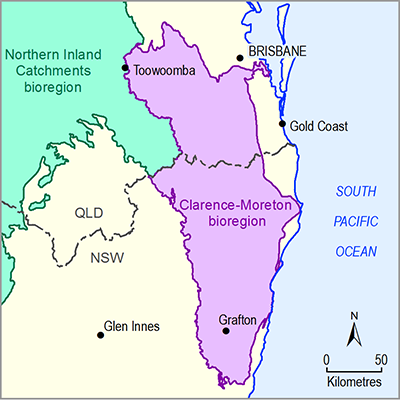- Home
- Assessments
- Bioregional Assessment Program
- Clarence-Moreton bioregion
- 1.1 Context statement for the Clarence-Moreton bioregion
- 1.1.4 Hydrogeology and groundwater quality
The groundwater bearing formations in the Clarence-Moreton bioregion include shallow water-bearing formations (aquifers) formed by the alluvium along river courses and floodplains and deeper formations composed of sedimentary or volcanic rocks. The important alluvial aquifers in the Clarence-Moreton bioregion include the Lockyer Valley alluvial aquifer, Bremer/Warrill alluvium, Logan/Albert river alluvium, Tweed River alluvium, Clarence River alluvium and the Richmond River alluvium. Some of these aquifers are economically important, for example, the Lockyer Valley alluvial aquifer, which is heavily stressed seasonally as it is used for irrigation, with continuous monitoring of water quality and quantity.
The alluvial aquifer systems are typically less than 35 m thick and are tapped using shallow wells. In contrast, deeper aquifers, such as the sandstone aquifers in the Walloon Coal Measures and Koukandowie Formations, vary in their water qualities and are not typically used for beneficial purposes. They are often below a few hundred metres from the ground surface and their water-bearing capacity varies considerably depending on lithological variability.
Their groundwater quality ranges from brackish to saline with maximum salinities equivalent to half the salinity of sea water reported locally. Flow of water in the alluvial aquifers in the Clarence-Moreton bioregion is controlled by a number of factors. An important control is the flow of the associated creek or river, and the alluvial aquifers are often directly connected to the ground surface and are fed by diffuse recharge from rainfall and stream recharge. Thus, the water level and availability in these aquifers are directly related to the recharge and groundwater use. The intake beds of the deeper bedrock aquifers are often not on the ground surface immediately above them.
The Clarence-Moreton bioregion extends across the state boundary between Queensland and New South Wales. Queensland and New South Wales governments have established Water Resource Plans and Water Sharing Plans to guide the management of the water in these aquifers. They organise different aquifers into different groundwater management areas and sustainable groundwater use volumes are estimated for each aquifer.
Groundwater quality and quantity monitoring data availability varies considerably across different aquifers in the Clarence-Moreton bioregion. While alluvial aquifers such as the Lockyer Valley alluvium has a considerable number of monitoring bores, most deep bedrock aquifers are only monitored by a few observation bores in the entire basin. One of the key challenges for the Clarence-Moreton Bioregional Assessment will be to deal with this scarcity of data across deep rock formations and provide recommendations as to what data (and where) will be required for future assessments.

Product Finalisation date
- 1.1.1 Bioregion
- 1.1.2 Geography
- 1.1.3 Geology
- 1.1.4 Hydrogeology and groundwater quality
- 1.1.5 Surface water hydrology and surface water quality
- 1.1.6 Surface water – groundwater interactions
- 1.1.7 Ecology
- Citation
- Acknowledgements
- Contributors to the Technical Programme
- About this technical product
